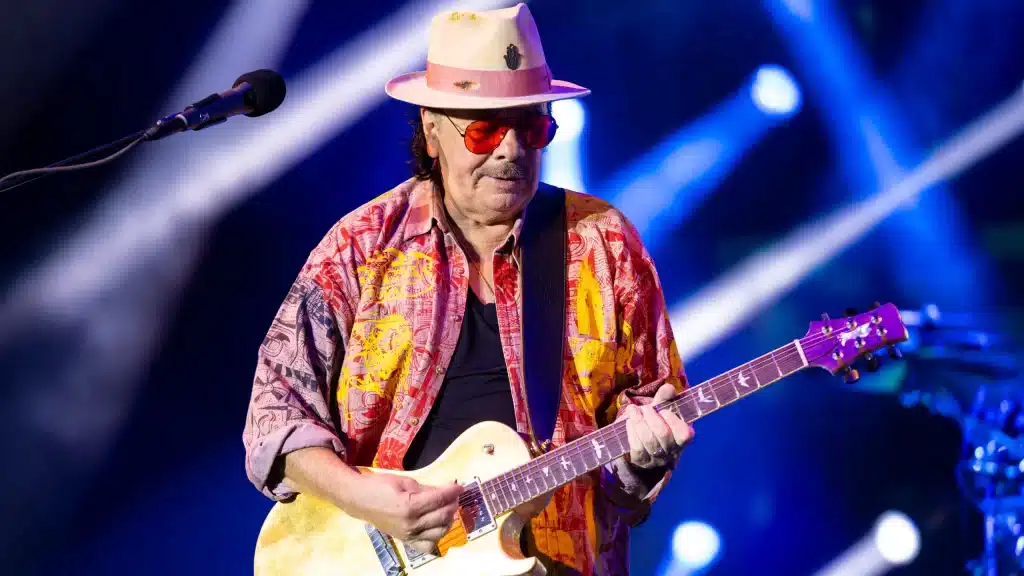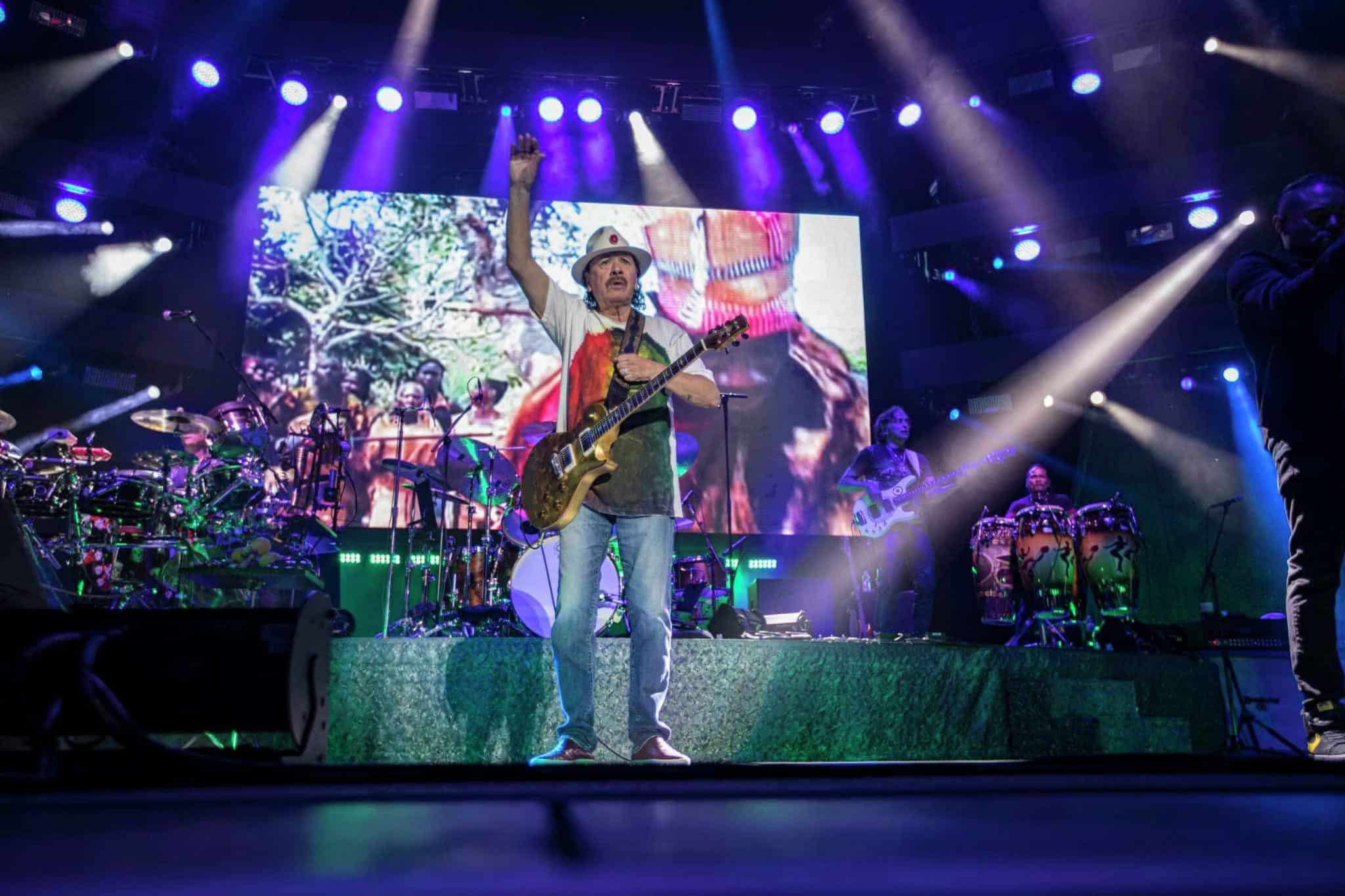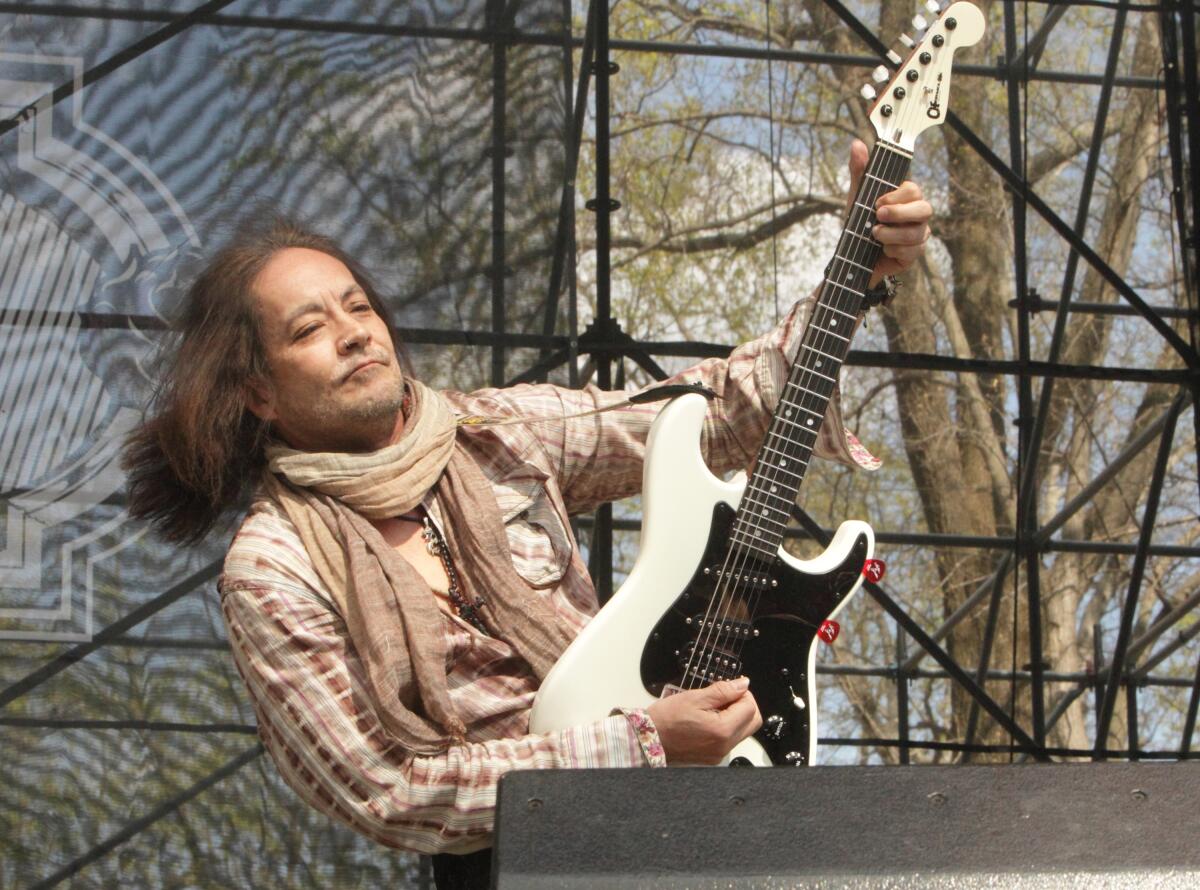Music
Carlos Santana Deletes Apology Over Trans Closet Comment
Carlos Santana has removed a Facebook apology he wrote after a viral video surfaced this week showing him saying transgender persons should stay “in the closet.” The 76-year-old musician can be seen interrupting the show in the video to share his opinions on gender identity with an audience of 5,000 people.
“When God made you and me, before we came out of the womb, you know who you are and what you are,” Santana, who grew up in San Francisco, said in the YouTube video, which was posted on Aug. 19.
“Later on, as you grow out of it, you see things and begin to believe that you could be something that sounds good, but you know it’s not right.” Because a woman is still a woman and a guy is still a man. That’s all. Whatever you want to do in the closet is your prerogative. That’s fine with me.”
Carlos Santana apologised on Facebook: “I realise that what I said hurt people, and that was not my intent.” I truly apologise to the transgender community and anyone else I may have upset.”
However, Carlos Santana had removed that statement from his Facebook profile by the next morning.
During his rant last month, filmed at a Hard Rock Live at the Etess Arena stop on his 1001 Rainbows Tour and first shared on Reddit, Santana also praised comedian Dave Chappelle, referring to the comedian who came under fire for making transphobic jokes in his 2021 Netflix special “The Closer” as “my brother.”
Santana’s words received criticism from a variety of sources, including San Francisco Pride executive director Suzanne Ford and board president Nguyen Pham.
“Carlos Santana’s recent anti-trans comments are particularly disheartening as he is a prominent Bay Area resident,” they said in a joint statement to the Chronicle.
“The fact that he used his incredible platform, onstage, to spew hate underscores the gravity of perpetuating misinformation in a society where gender’s spectrum is well-established.”
The incident occurred as anti-LGBTQ legislation was being introduced in state legislatures across the United States. Almost two dozen states have prohibited or limited transgender athletes from participating in sports at the K-12 or collegiate levels. Approximately 20 states have passed laws or policies, some of which have been overturned by courts, prohibiting gender-affirming medical care, such as puberty blockers, hormone therapy, and minor surgery.
“Carlos Santana’s influence necessitates responsible discourse, particularly given the marginalised position of transgender people facing discrimination and violence,” Ford and Pham wrote.
“As a community striving for inclusivity, we must use this moment to reinforce empathy, education, and unity in the face of discriminatory policies, and to encourage allies like Santana to use their influence to promote understanding rather than perpetuate harmful stereotypes.”
The debut of the video coincided with the release of tickets for Santana’s upcoming documentary, “Carlos: The Santana Journey,” directed by Emmy Award winner Rudy Valdez.
The documentary, which will air on September 23, will showcase previously unseen archive material charting Santana’s life from his childhood in Tijuana, Mexico, where he struggled with poverty and sexual assault, through his rise in the San Francisco music scene and subsequent international stardom.
Santana was up in San Francisco’s Mission District and attended Mission High School before breaking out with singles like “Black Magic Woman” and “Evil Ways,” as well as the multiplatinum “Supernatural” album in 1999.
Guitarist Carlos Santana currently resides in Las Vegas and will start his 11th year of residency at the House of Blues at Mandalay Bay next month, after a brief sabbatical due to a heart treatment in 2021.
Santana informed the audience at the same events where the viral video was taken, “We want you to feel precious and priceless because you are significant and meaningful.” It is critical to validate and appreciate yourself.”
Read: Former Whitesnake Guitarist Bernie Marsden Dead at 72
Music
Phil Lesh, Founding Member Of Grateful Dead And Influential Bassist, Dies At 84

Los Angeles — Phil Lesh, an 84-year-old classically trained violinist and jazz trumpeter who discovered his real calling as a founding member of the Grateful Dead by reimagining the position of rock bass guitar, died Friday.
Lesh’s death was confirmed via his Instagram account. Lesh was the eldest and one of the most enduring members of the band that helped define the acid rock sound originating from San Francisco in the 1960s.
“Phil Lesh, the bassist and founding member of the Grateful Dead, died peacefully this morning. He was surrounded by his family and filled with affection. According to the Instagram message, Phil gave enormous delight to everyone around him and left a legacy of music and love.
The message did not specify the cause of death, and attempts to contact spokespeople for more information were not immediately successful. Lesh had already survived prostate and bladder cancer, as well as a liver transplant in 1998 due to the devastating effects of a hepatitis C infection and years of excessive drinking.
Lesh died two days after MusiCares named the Grateful Dead their Persons of the Year. MusiCares, which assists music professionals needing financial or other support, mentioned Lesh’s Unbroken Chain Foundation, among other charity projects. The Dead will be honored in January at a fundraiser dinner in Los Angeles before the Grammy Awards.
Although he kept a low public profile, rarely giving interviews or speaking in front of an audience, fans and fellow band members recognized Lesh as an important member of the Grateful Dead, whose thundering lines on the six-string electric bass provided a brilliant counterpoint to lead guitarist Jerry Garcia’s soaring solos and anchored the band’s famous marathon jam sessions.
Phil Lesh, Founding Member Of Grateful Dead And Influential Bassist, Dies At 84
“When Phil’s happening, the band’s happening,” Garcia famously said.
Drummer Mickey Hart described him as the group’s intellectual, bringing a classical composer’s attitude and skills to a five-chord rock ‘n’ roll outfit.
Lesh credited Garcia for training him to play the bass in the unconventional lead-guitar style for which he would become famous, combining thundering arpeggios with fragments of spontaneously arranged symphonic passages.
A fellow bass player, Rob Wasserman, once stated that Lesh’s style distinguished him from every other bassist he knew. While most others were willing to keep time and play the occasional solo, Wasserman said Lesh was good and confident enough to lead his bandmates through a song’s melody.
“He happens to play bass but he’s more like a horn player, doing all those arpeggios — and he has that counterpoint going all the time,” he told me.
Lesh began his long musical journey as a classically trained violinist, taking third-grade lessons. He began playing the trumpet at 14 and rose to second chair in California’s Oakland Symphony Orchestra while still in his teens.
In 1965, however, he had mostly abandoned both instruments and was working as a sound engineer for a tiny radio station when Garcia approached him to play bass in The Warlocks, a young rock band.
When Lesh informed Garcia that he didn’t play bass, the musician inquired, “Didn’t you used to play violin?” When he responded yes, Garcia said, “There you go, man.”
Lesh sat down for a seven-hour lesson with Garcia, armed with a cheap four-string instrument purchased by his girlfriend, and followed the latter’s advice to tune his instrument’s strings an octave lower than Garcia’s guitar’s four bottom strings. Then Garcia let him go, allowing Lesh to establish the spontaneous playing style he would keep for the rest of his life.
Lesh and Garcia frequently exchanged leads, sometimes spontaneously, and the band as a whole frequently broke into long experimental, jazz-influenced jams during concerts. As a result, even well-known Grateful Dead tunes like “Truckin'” or “Sugar Magnolia” rarely sounded the same twice in a row, which drew faithful fans back to each show.
“It’s always fluid, we just pretty much figure it out on the fly,” Lesh said, chuckling, in a rare 2009 interview with The Associated Press. “You can’t set those things in stone in the rehearsal room.”
Phillip Chapman Lesh was born on March 15, 1940, in Berkeley, California, as the sole child of Frank Lesh, an office equipment repairman, and his wife, Barbara.
In later years, he claimed that listening to New York Philharmonic broadcasts on his grandmother’s radio sparked his interest in music. One of his earliest memories was listening to the famous German composer Bruno Walter conduct the orchestra through Brahms’ First Symphony.
He frequently listed composers such as Bach and Edgard Varèse and jazz legends such as John Coltrane and Miles Davis as his musical influences.
By the time he arrived at the College of San Mateo, Lesh had transitioned from classical music to cool jazz. He eventually became the first trumpet player in the school’s big band and composed several orchestral compositions for the ensemble to perform.
Soon after Lesh began playing bass, The Warlocks changed their name to the Grateful Dead, and Lesh began to captivate audiences with his agility. Crowds congregated in what became known as “The Phil Zone” just before his stage location.
Phil Lesh, Founding Member Of Grateful Dead And Influential Bassist, Dies At 84
Although Lesh was never a prolific songwriter, he did compose music for and occasionally sang some of the band’s most popular songs. These included the lively country song “Pride of Cucamonga,” the jazz-influenced “Unbroken Chain,” and the hauntingly beautiful “Box of Rain.”
Lesh wrote the latter on guitar as a gift for his dying father. He said that after hearing the instrumental recording, Grateful Dead lyricist Robert Hunter contacted him the next day with a lyric sheet. That sheet, he claimed, included “some of the most moving and heartfelt lyrics I’ve ever had the good fortune to sing.”
The song was frequently played at the end of the band’s shows.
After the group disbanded following Garcia’s death in 1995, Lesh frequently skipped performances with the other members.
He participated in a 2009 Grateful Dead tour and again in 2015 for a handful of “Fare Thee Well” shows commemorating both the band’s 50th anniversary and Lesh’s final performance with the others.
However, he continued to perform frequently with a revolving band of musicians he dubbed Phil Lesh and Friends.
In later years, he mainly performed at Terrapin Crossroads, a restaurant and nightclub he founded near his Northern California home in 2012 and named after the Grateful Dead song and album “Terrapin Station.”
Lesh is survived by his wife, Jill, and two kids, Brian and Grahame.
SOURCE | AP
Music
One Direction Singer Liam Payne Found Dead In Buenos Aires, Local Media Reports

Former One Direction singer Liam Payne died outside a hotel in the Argentine capital Buenos Aires on Wednesday, according to local media.
The 31-year-old British musician fell from the building’s third story.
According to officials, leading local newspapers La Nacion and Clarin reported that police were dispatched to the hotel in the capital’s beautiful Palermo neighborhood in response to an emergency call describing “an aggressive man who may be under the influence of drugs and alcohol.”
According to news sources, ambulance workers confirmed the singer’s death after finding him in an inside hotel patio.
One Direction Singer Liam Payne Found Dead In Buenos Aires, Local Media Reports
Liam Payne rocketed to global popularity as a member of the now-defunct pop band One Direction, alongside Harry Styles, Zayn Malik, Niall Horan, and Louis Tomlinson.
The boy band formed after finishing third on the British edition of the X Factor music competition show in 2010, however, the group disbanded in 2016 as its members pursued various pursuits, including individual careers.
SOURCE | Reuters
Music
Former Ozzy Osbourne Guitarist Jake E. Lee Shot 6 Times In Las Vegas

LAS VEGAS — Jake E. Lee, Ozzy Osbourne’s former guitarist, was shot and injured many times in Las Vegas early Tuesday morning.
According to an emailed statement from Las Vegas police, the victim was shot around 2:40 a.m. Tuesday and taken to the hospital for treatment. There have been no arrests, and the police department said the investigation into the incident, which occurred in a suburb about 10 miles (16 kilometers) south of the Strip, is still ongoing.
Former Ozzy Osbourne Guitarist Jake E. Lee Shot Multiple Times In Las Vegas
“No further comments will be made while the incident is being investigated by the police.” “Jake and his family appreciate your respect for their privacy at this time,” the message stated.
Amanda Cagan, the representative, said the incident occurred as Lee was walking his dog.
“By the grace of God, no major organs were hit, he’s fully responsive, and expected to make a full recovery,” Tim Heyne, manager for Lee’s rock band Red Dragon Cartel, told The Associated Press.
Former Ozzy Osbourne Guitarist Jake E. Lee Shot Multiple Times In Las Vegas
Jake, 67, was born in Norfolk, Virginia, and reared in San Diego. He played guitar in various bands on Los Angeles’ Sunset Strip during the 1980s glam metal movement, including an early version of Ratt.
He joined Ozzy Osbourne’s band in 1982 and stayed until 1987, appearing on albums such as 1983’s “Bark at the Moon.” He later played in the metal band Badlands and released two solo albums. He most recently led the Red Dragon Cartel.
SOURCE | AP
-
Politics2 weeks ago
Trudeau Orders Facebook to Block Australian Presser Video
-
Business4 weeks ago
Canada CBC News CEO Catherine Tait Recalled to Parliamentary Committee
-
Celebrity4 weeks ago
Shaun White’s Proposal To Nina Dobrev Was Romantic Gold
-
Tech4 weeks ago
Apple Launches The IPhone Into The AI Era With Free Software Update
-
News3 weeks ago
Pro-Khalistanis Sikhs Attack Hindu Temple in Brampton
-
Food4 weeks ago
Starbucks Is Making A Popular Add-On Free Of Charge



























